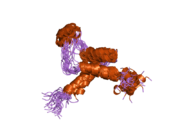Biology:TEAD3
From HandWiki
Short description: Protein-coding gene in the species Homo sapiens
 Generic protein structure example |
Transcriptional enhancer factor TEF-5 is a protein that in humans is encoded by the TEAD3 gene.[1][2][3]
Function
This gene product is a member of the transcriptional enhancer factor (TEF) family of transcription factors, which contain the TEA/ATTS DNA-binding domain.[4] Members of the family in mammals are TEAD1, TEAD2, TEAD3, TEAD4. Transcriptional coregulators, such as WWTR1 (TAZ) bind to these transcription factors. TEAD3 is predominantly expressed in the placenta and is involved in the transactivation of the chorionic somatomammotropin-B gene enhancer. It is expressed in nervous system and muscle in fish embryos.[5] Translation of this protein is initiated at a non-AUG (AUA) start codon.[3]
References
- ↑ "Localization of human transcription factor TEF-4 and TEF-5 (TEAD2, TEAD3) genes to chromosomes 19q13.3 and 6p21.2 using fluorescence in situ hybridization and radiation hybrid analysis". Genomics 55 (1): 127–9. Jan 1999. doi:10.1006/geno.1998.5628. PMID 9889009.
- ↑ "Human TEF-5 is preferentially expressed in placenta and binds to multiple functional elements of the human chorionic somatomammotropin-B gene enhancer". The Journal of Biological Chemistry 272 (20): 12928–37. May 1997. doi:10.1074/jbc.272.20.12928. PMID 9148898.
- ↑ 3.0 3.1 "Entrez Gene: TEAD3 TEA domain family member 3". https://www.ncbi.nlm.nih.gov/sites/entrez?Db=gene&Cmd=ShowDetailView&TermToSearch=7005.
- ↑ "The TEA domain: a novel, highly conserved DNA-binding motif". Cell 66 (1): 11–12. Jul 1991. doi:10.1016/0092-8674(91)90132-I. PMID 2070413.
- ↑ "Vestigial-like-2b (VITO-1b) and Tead-3a (Tef-5a) expression in zebrafish skeletal muscle, brain and notochord". Gene Expression Patterns 7 (8): 827–36. Oct 2007. doi:10.1016/j.modgep.2007.08.001. PMID 17916448.
Further reading
- "Human placental TEF-5 transactivates the human chorionic somatomammotropin gene enhancer". Molecular Endocrinology 13 (6): 879–89. Jun 1999. doi:10.1210/mend.13.6.0288. PMID 10379887.
- "TONDU (TDU), a novel human protein related to the product of vestigial (vg) gene of Drosophila melanogaster interacts with vertebrate TEF factors and substitutes for Vg function in wing formation". Development 126 (21): 4807–16. Nov 1999. doi:10.1242/dev.126.21.4807. PMID 10518497.
- "TEAD/TEF transcription factors utilize the activation domain of YAP65, a Src/Yes-associated protein localized in the cytoplasm". Genes & Development 15 (10): 1229–41. May 2001. doi:10.1101/gad.888601. PMID 11358867.
- "Mouse DTEF-1 (ETFR-1, TEF-5) is a transcriptional activator in alpha 1-adrenergic agonist-stimulated cardiac myocytes". The Journal of Biological Chemistry 277 (27): 24346–52. Jul 2002. doi:10.1074/jbc.M201171200. PMID 11986313.
- "Transcription enhancer factor-5 and a GATA-like protein determine placental-specific expression of the Type I human 3beta-hydroxysteroid dehydrogenase gene, HSD3B1". Molecular Endocrinology 18 (8): 2049–60. Aug 2004. doi:10.1210/me.2004-0028. PMID 15131259.
External links
- TEAD3+protein,+human at the US National Library of Medicine Medical Subject Headings (MeSH)
 |


